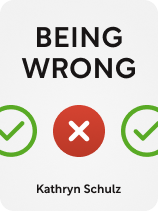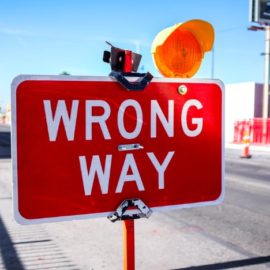

This article is an excerpt from the Shortform book guide to "Being Wrong" by Kathryn Schulz. Shortform has the world's best summaries and analyses of books you should be reading.
Like this article? Sign up for a free trial here.
Do you know how your beliefs are formed? What if many of them are based on faulty information?
In her book Being Wrong, Kathryn Schulz explores the fascinating process of how beliefs are formed. She discusses the ways our senses and storytelling abilities can lead us astray, creating beliefs that may not align with reality.
Keep reading to discover the surprising ways your mind works in the formation of beliefs.
The Formation of Beliefs
Our potentially faulty judgments based on erroneous sensory data form the shaky foundations on which we build beliefs, giving us even more chances to be wrong. Our beliefs shape everything we do, and they’re so interwoven and interconnected that admitting one of them is wrong can threaten our entire framework of understanding. Schulz discusses how beliefs are formed and how easily we invent them on the fly with little or no evidence to back them up.
Beliefs are stories we tell about the world. We’re conscious of some, such as beliefs about money, but unconscious of others, such as which way is “down.” We cling to some beliefs very tightly, while others change more easily, depending on how important they are. Schulz says that we automatically form beliefs about every new thing or idea we encounter, because otherwise we wouldn’t have a way to determine how to act or predict what will happen. This belief formation is a two-pronged approach—part of your mind creates a story to explain what your senses tell you, while another part of your mind checks your story against further input from your senses. Either side of this process can break down, resulting in beliefs that are wrong.
An example in which your senses and storytelling contribute to faulty beliefs is that of a well-performed magic trick. In this instance, though, the limits of your senses are deliberately “hacked” by the magician. Magicians conceal the mechanics of the trick so that no matter how closely you watch, you’re deprived of essential information about it, just as Schulz asserts that we are in most situations we experience. Meanwhile, the magician provides a running commentary to shape the narrative forming in your mind—one that’s at odds with the reality of how the trick is actually performed. Even when you know that what you’re seeing isn’t possible, it’s hard to disbelieve the evidence of your eyes and the story the magician tells you.
| Your Mind May Deceive You One example of how an illusionist can create a visual narrative that’s at odds with reality is the classic cup-and-balls magic trick in which a ball (or some other object) seems to transport itself through solid matter, from underneath one cup into another. This trick was famously ruined by the magicians Penn and Teller who perform the trick using clear plastic cups so that the audience can see exactly how they’re being fooled. But as Schulz points out regarding belief, even when Penn and Teller explicitly show how they pull off the illusion, the props in the trick still seem to magically move. In a broader sense, the process by which your senses interact with your internal narrative to understand the things you experience is built into the brain’s basic structure. In My Stroke of Insight, neuroscientist Jill Bolte Taylor explains that as you take information in from your senses, your brain’s right hemisphere builds a sensory picture of the world around you, while your brain’s left hemisphere takes that sensory picture and classifies what’s in it using language and numbers. The left brain creates a story based on what the right brain perceives. This chain of processes creates multiple steps where the cognitive errors that Schulz discusses can inject themselves into our mental models of the world. |
Your senses can fail you, but the storytelling aspect of your brain goes wrong when you spin beliefs from sheer imagination. Schulz acknowledges that imagination is an evolutionary gift that lets us solve problems we’ve never faced before, but it goes wrong when we invent stories without any evidential grounding. We do this because our minds crave answers, so we feed them by making up theories. For instance, if your cat disappears and shows up again, you’ll automatically start guessing where it went. The trouble is that these guesses quickly solidify into firmly held beliefs. Admitting that you don’t know something is more uncomfortable than pretending that you do, hence the temptation to believe things too strongly.
| When Guessing Goes Wrong When your mind creates guesses out of whole cloth, it doesn’t do so entirely at random. In Thinking, Fast and Slow, behavioral psychologist Daniel Kahneman—who’s made a career out of studying human error—lists several basic mental heuristics which often lead us astray. These include but are not limited to: 1) Making judgments based on too few examples. For instance, if you see two police cars near each other, you may conclude that there are many more police patrolling the area in force. 2) Seeing patterns where none exist. In the US, it often seems like mobile homes are somehow targeted by tornados, when in fact they’re no more likely than any other structure to be in a tornado’s path. 3) The Anchor Effect. When presented with several pieces of information, you tend to focus on what you’re shown first. For example, if a salesperson gives you a range of prices and then asks you how much something should cost, your answer is likely to veer toward whatever number they mentioned first. Schulz speaks of the instinctive nature by which we use these and other heuristics to form beliefs and make decisions even when there’s little to no information. But in line with Schulz’s thesis that making mistakes isn’t always a bad thing, Kahneman argues that the brain’s error-prone heuristics can be consciously leveraged to help you lead a happy life. |

———End of Preview———
Like what you just read? Read the rest of the world's best book summary and analysis of Kathryn Schulz's "Being Wrong" at Shortform.
Here's what you'll find in our full Being Wrong summary:
- Why you shouldn’t try to completely avoid making mistakes
- The reasons why you get things wrong
- How to make mistakes without falling victim to shame and denial






